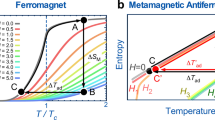Play all audios:

ABSTRACT CONTINUING our experiments1 with the magnetic method, we investigated the suitability of a number of substances. The efficiency of a substance for this purpose can be defined by a
characteristic temperature m, which may be calculated by means of a formula which we derived under certain simplifying assumptions about the splitting of the ground state of the magnetic
ions. According to this formula, the final temperature reached in demagnetising to the field zero is inversely proportional to the initial magnetic field, proportional to the initial
temperature and to the temperature m, characteristic for each substance, defined by m = _U_/_k_ (_U_ = energy difference between the adjacent levels of the ground state, _k_ =
Boltzmann's constant). Thus, the smaller m, the more suitable is the substance for attaining low temperatures. Access through your institution Buy or subscribe This is a preview of
subscription content, access via your institution ACCESS OPTIONS Access through your institution Subscribe to this journal Receive 51 print issues and online access $199.00 per year only
$3.90 per issue Learn more Buy this article * Purchase on SpringerLink * Instant access to full article PDF Buy now Prices may be subject to local taxes which are calculated during checkout
ADDITIONAL ACCESS OPTIONS: * Log in * Learn about institutional subscriptions * Read our FAQs * Contact customer support SIMILAR CONTENT BEING VIEWED BY OTHERS HIGH-EFFICIENCY MAGNETIC
REFRIGERATION USING HOLMIUM Article Open access 19 February 2021 EXPONENTIALLY FASTER COOLING IN A COLLOIDAL SYSTEM Article 05 August 2020 TUTORIAL: A BEGINNER’S GUIDE TO INTERPRETING
MAGNETIC SUSCEPTIBILITY DATA WITH THE CURIE-WEISS LAW Article Open access 19 April 2022 REFERENCES * N. Kürti and F. Simon, _NATURE_, 133, 907; 1934. _Physica_, 1, 1107; 1934. A detailed
report will appear shortly. Article ADS Google Scholar * Our results with this substance agree satisfactorily with those of Giauque and MacDougall, _Phys. Rev._, 44, 235; 1933. Article
CAS ADS Google Scholar * W. J. Haas and E. C. Wiersma, _Physica_, 1, 779; 1934. Article ADS Google Scholar * See Debye, _Sitzungsber., Math. Phys. Kl. Sachs. Akad. Wiss._, 83, 105;
1934. Google Scholar * See, for example, F. Simon, _Z. Phys._, 81, 826; 1933. ADS Google Scholar Download references AUTHOR INFORMATION AUTHORS AND AFFILIATIONS * Clarendon Laboratory,
Oxford N. KÜRTI & F. SIMON Authors * N. KÜRTI View author publications You can also search for this author inPubMed Google Scholar * F. SIMON View author publications You can also search
for this author inPubMed Google Scholar RIGHTS AND PERMISSIONS Reprints and permissions ABOUT THIS ARTICLE CITE THIS ARTICLE KÜRTI, N., SIMON, F. Further Experiments with the Magnetic
Cooling Method. _Nature_ 135, 31 (1935). https://doi.org/10.1038/135031a0 Download citation * Issue Date: 05 January 1935 * DOI: https://doi.org/10.1038/135031a0 SHARE THIS ARTICLE Anyone
you share the following link with will be able to read this content: Get shareable link Sorry, a shareable link is not currently available for this article. Copy to clipboard Provided by the
Springer Nature SharedIt content-sharing initiative
